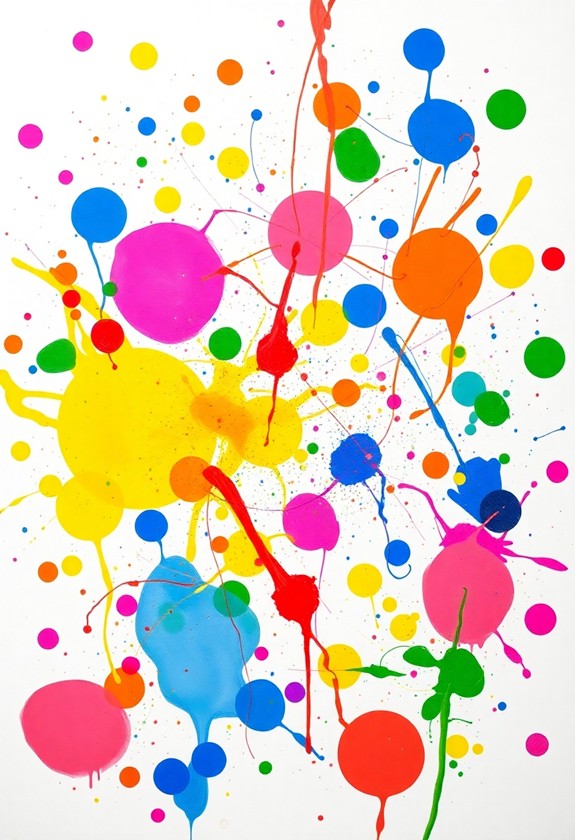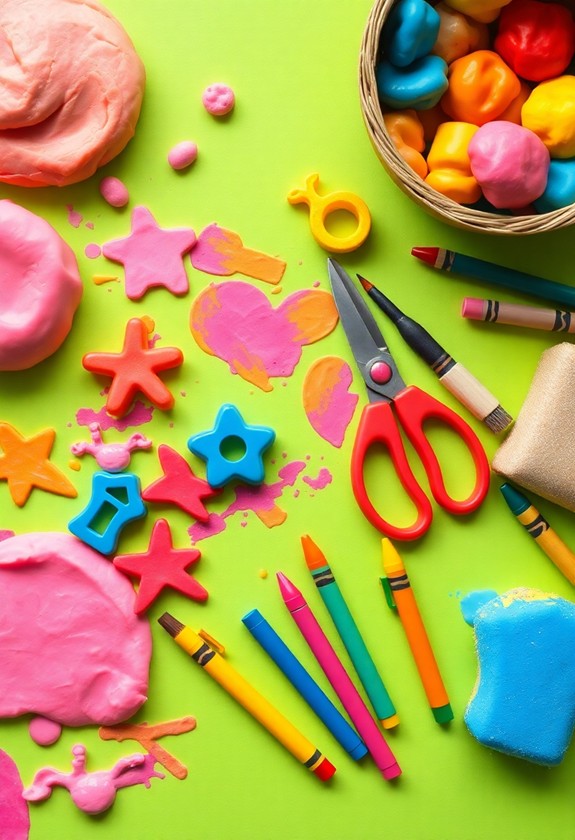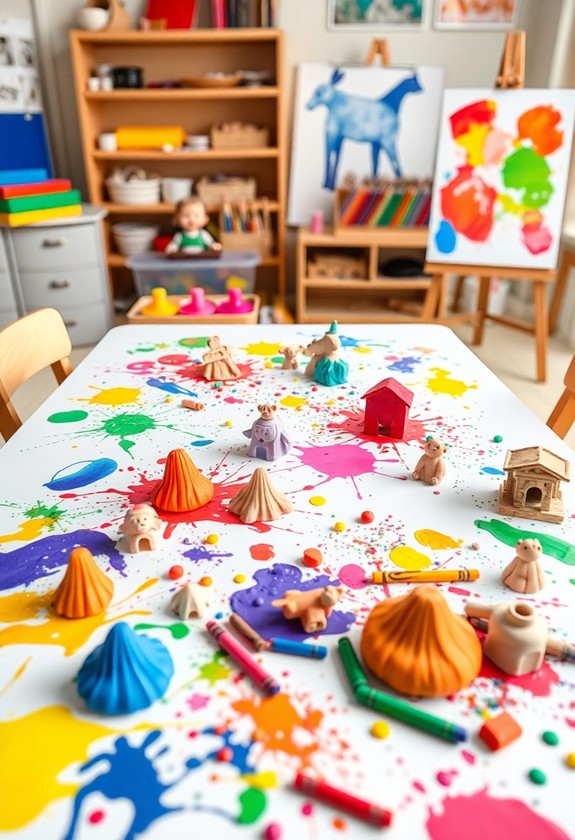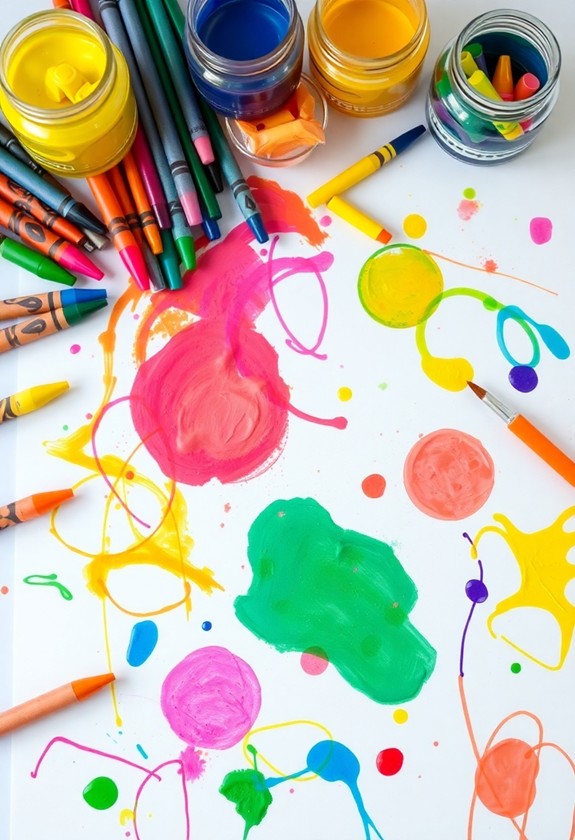Toddler art isn't just messy fun—it's a stress-busting developmental powerhouse! Your little one can relax through sensory exploration, express emotions with colors, and boost fine motor skills. Art activities promote mindfulness, keeping kiddos focused on the present moment. Creating masterpieces builds self-esteem and confidence, as well as providing precious bonding time for you both. Plus, your child's cognitive growth gets a creative kick-start! From finger painting to play-dough sculpting, artistic adventures offer a world of benefits. So grab those washable paints and get ready to witness your tot's imagination soar! There's even more colorful magic waiting to be uncovered.
Creative Highlights
- Sensory exploration through art activities promotes relaxation and stress relief while developing fine motor skills.
- Emotional expression through color choices helps toddlers process feelings and reduce stress.
- Mindfulness and present-moment focus during art creation enhance emotional regulation and calmness.
- Art-making boosts self-esteem and confidence, reducing stress through a sense of accomplishment.
- Parent-child bonding during art activities strengthens relationships and provides emotional support.
Sensory Exploration and Relaxation
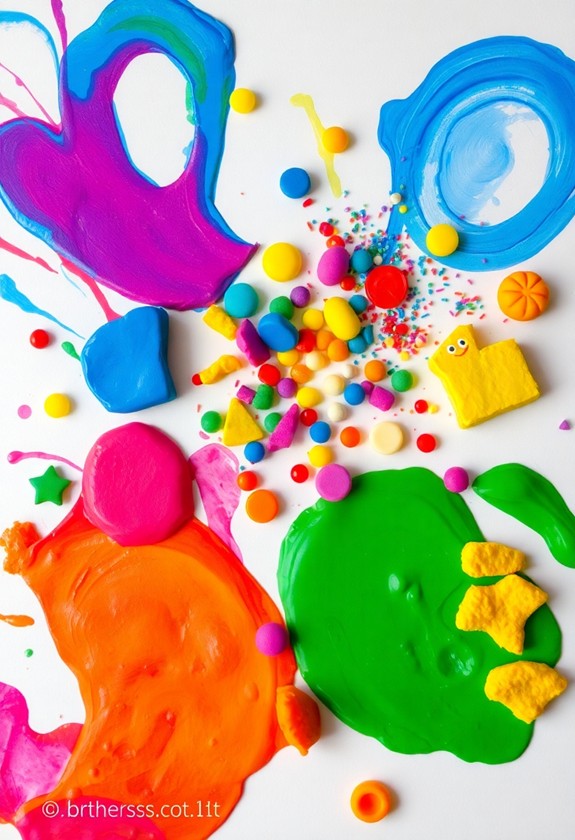
Diving into the world of sensory exploration, toddlers can find remarkable relaxation through art activities. Watch as your little one squishes play-dough, splashes in finger paint, or scribbles with crayons – they're not just making a mess, they're de-stressing! These hands-on experiences engage multiple senses, helping your tot unwind and focus on the present moment. Stress relief through creative outlets is a key benefit of arts and crafts for kids, promoting both relaxation and cognitive development.
Try these sensory art ideas:
- Squishy stress balls: Fill balloons with flour for a squishy, calming sensation
- Textured painting: Use bubble wrap, sponges, or leaves to create unique patterns
- Sand art: Draw in colored sand for a tactile, visual treat
But wait, there's more! These activities aren't just fun and relaxing – they're building fine motor skills and creativity too. It's a win-win situation that'll have your toddler grinning from ear to ear. So, let's get messy and mellow!
Emotional Expression Through Color
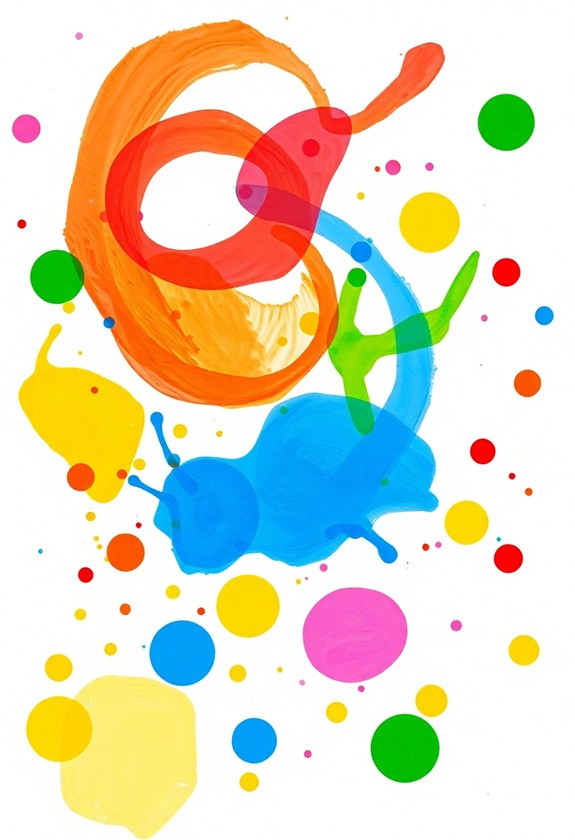
Bursting with lively hues, color becomes a powerful tool for emotional expression in toddler art. Watch as your little one's feelings come alive on paper! Red might show anger or excitement, whereas blue could represent calmness or sadness. It's like a rainbow of emotions! Washable finger paints are perfect for this sensory investigation, allowing toddlers to directly engage with colors using their hands. Their non-toxic formulation guarantees safe and worry-free creative play.
Encourage your tot to investigate their feelings through color:
- Let them choose their own colors freely
- Ask what each color means to them
- Notice patterns in their color choices
You'll be amazed at how much you'll learn about your child's inner world! And the best part? This colorful adventure helps them process emotions and reduce stress. It's a win-win situation that's as clear as black and white! So grab those crayons, markers, or paints, and let the color therapy begin. Your little Picasso's masterpieces will be both beautiful and stress-busting!
Fine Motor Skill Development
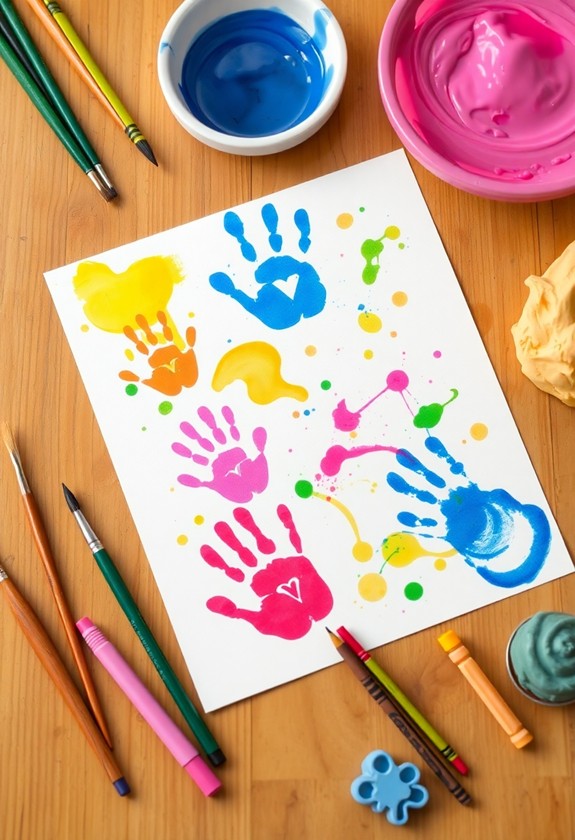
As toddlers express themselves through color, they're also developing important fine motor skills. Every scribble, smear, and splash is a workout for their tiny hands! Watch as they grasp crayons, squeeze paint bottles, and manipulate brushes – it's like a mini gym for their fingers! Skillmatics and YPLUS offer engaging craft kits that deliberately target these skills, providing a structured approach to creative development. Regular crafting activities stimulate brain regions associated with problem-solving and motor skills, laying a strong foundation for future learning.
These artistic adventures help your little one:
- Improve hand-eye coordination
- Strengthen finger and hand muscles
- Refine their pincer grasp
And the best part? It's all fun and games to them! They're not just creating masterpieces; they're building the foundation for future skills like writing, tying shoelaces, and using utensils. So, next time you see your toddler gleefully making a mess with art supplies, remember: they're actually "drawing" their way to better fine motor skills! It's a win-win situation that's both colorful and significant for development.
Mindfulness and Present Moment Focus
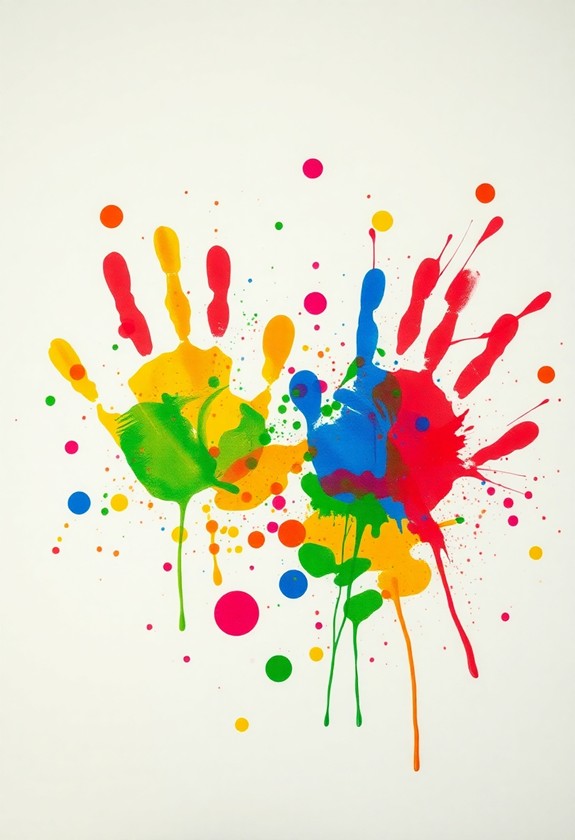
Though fine motor skills are crucial, toddler art also offers a gateway to mindfulness and present moment focus. When your little one plunges into their artistic endeavors, they're fully immersed in the now! It's like a mini-meditation session, but with more mess and giggles. Educational kits like those combining creativity with science education can further improve this immersive experience, promoting both learning and mindfulness simultaneously.
Here's how art promotes mindfulness for your tiny Picasso:
- Sensory engagement: Squishing paint, feeling textures – it's a feast for the senses!
- Concentration: Watch as they zero in on their masterpiece with laser focus.
- Emotional regulation: Art helps them express and process feelings in the moment.
Boosting Self-Esteem and Confidence
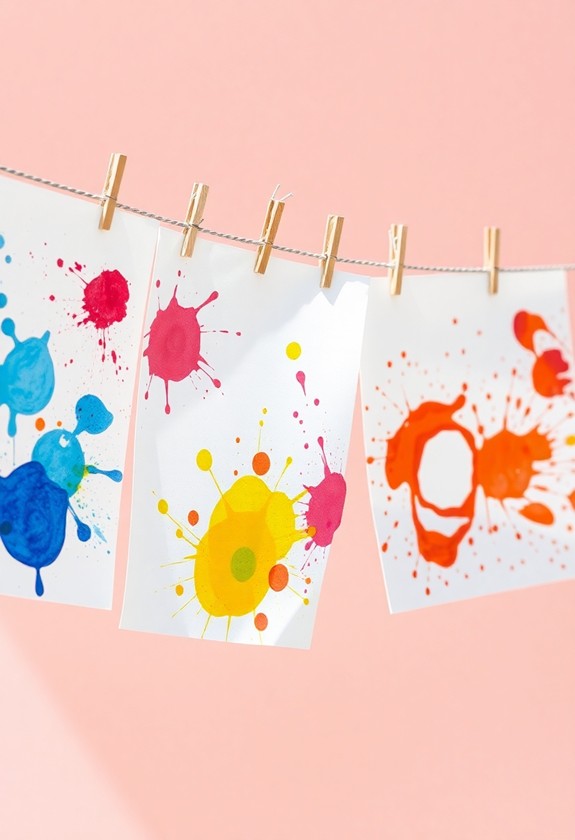
In relation to boosting self-esteem and confidence, toddler art plays a vital role. When your little one creates something, they're building a sense of accomplishment! Every scribble, finger painting, or playdough sculpture is a chance for them to shine. You'll see their eyes light up as they proudly show off their masterpiece. Finger painting activities are particularly beneficial, as they improve sensory exploration and promote emotional expression, further contributing to your child's self-esteem development.
Here's how toddler art boosts confidence:
- It's all about the process, not perfection
- They make choices and solve problems
- You provide positive reinforcement
Your toddler's artistic expedition is a confidence-building adventure! As they experiment with colors, shapes, and textures, they're additionally developing vital skills. And the best part? They're having a blast whilst doing it! So, grab those crayons and let the creativity flow. You're not just making art – you're crafting self-esteem!
Parent-Child Bonding Opportunities
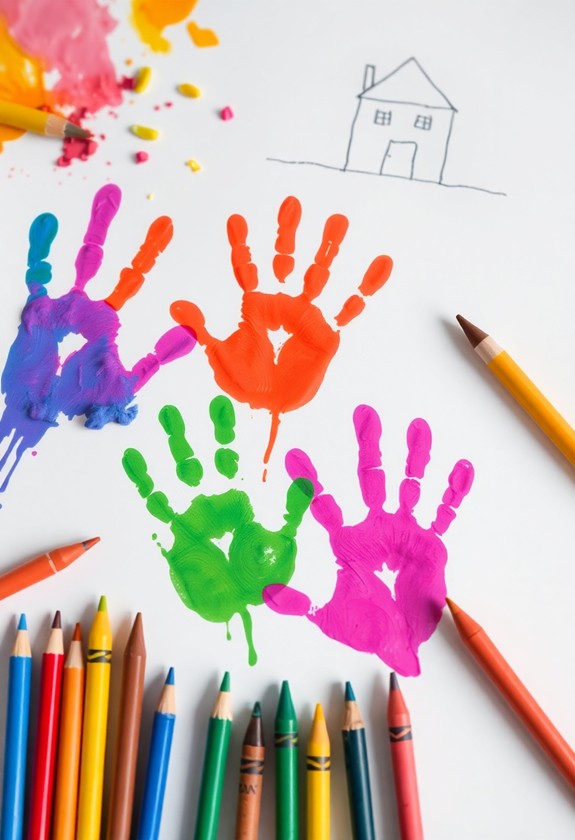
Toddler art frequently offers incredible opportunities for parent-child bonding. It's a chance to connect, laugh, and create memories together! When you sit down with your little one to paint, draw, or sculpt, you're building a special connection that'll last a lifetime.
Here's how to make the most of your artsy bonding time:
- Get messy together! Don't be afraid to plunge in and get your hands dirty.
- Ask questions about their creations. "What's that blue squiggle?"
- Share your own artistic attempts. Your toddler will love seeing you try!
- Display their masterpieces proudly. It shows you value their efforts.
Cognitive Growth Through Creativity
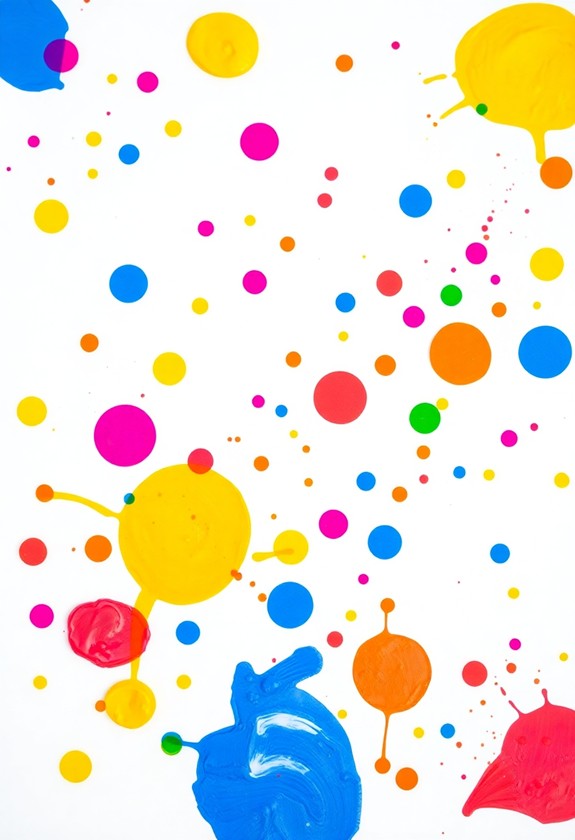
Creativity often serves as a powerful catalyst for cognitive development in toddlers. When your little one engages in art, they're not just making cute pictures—they're building brainpower! Through drawing, painting, and crafting, your child is:
- Developing problem-solving skills
- Enhancing fine motor abilities
- Boosting spatial awareness
- Expanding language skills
It's like a workout for their growing minds! As they decide what colors to use or how to represent objects, they're flexing their mental muscles. And the best part? It's fun! Your toddler won't even realize they're learning as they create masterpieces.
Curious Little Questions
What Age Is Considered a Toddler for Art Activities?
You might be wondering, what's the perfect age for toddler art? Well, get ready for some colorful news! Typically, a toddler is considered between 1 and 3 years old. But don't let that limit you! Even younger kiddos can get creative. As soon as they can grasp a crayon, they're ready to go! Remember, every child develops differently. So, whether they're 12 months or 36 months, it's never too early (or late) to start splashing, splattering, and scribbling their way to artistic greatness!
Are There Any Safety Concerns With Toddlers Using Art Supplies?
You bet there are safety concerns with toddlers and art supplies! Keep a watchful eye on your little Picasso. Here's the scoop:
- Choking hazards: No small items!
- Toxic materials: Stick to non-toxic, washable supplies
- Messy mishaps: Use smocks and cover surfaces
- Sharp objects: Avoid scissors and pointy tools
How Often Should Toddlers Engage in Art Activities?
Like a butterfly emerging from its cocoon, your toddler's creativity blossoms with regular art time! You should aim for daily art activities, regardless of how short they are. Mix it up with:
- Drawing
- Painting
- Sculpting with play-dough
But don't sweat it if you miss a day! The key is consistency, not perfection. Let your little Picasso wander freely for 10-20 minutes at a time. And remember, it's about the process, not the product. So grab those crayons and let the fun begin!
What Are the Best Art Materials for Toddlers?
Ready to spark your toddler's creativity? You'll love these top art materials! Start with chunky, non-toxic crayons and washable markers – perfect for little hands! Don't forget finger paints, they're a messy blast! Playdough is a squishy sensation that'll keep them engaged for hours. And for a sensory adventure, try textured papers or foam shapes. Remember, safety first! Always supervise and choose age-appropriate materials. With these tools, your little Picasso will be creating masterpieces in no time!
Can Toddler Art Activities Help With Language Development?
You'll be amazed at how toddler art activities can enhance language development! As your little one creates, they're learning new words for colors, shapes, and textures. They'll excitedly describe their masterpieces, boosting vocabulary and communication skills. And don't forget the chit-chat during art time! It's a golden opportunity for you to engage in meaningful conversations, ask questions, and encourage your tot to express themselves. So grab those crayons and let the language learning begin!

